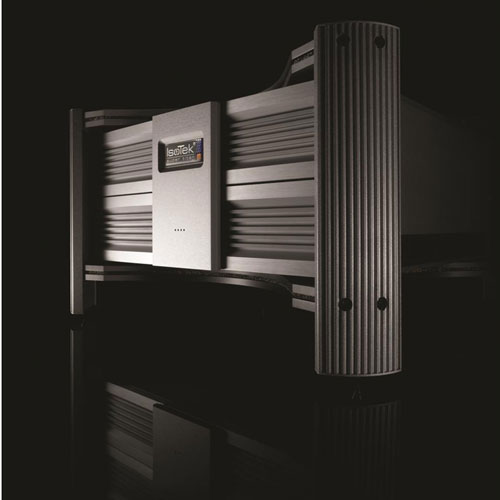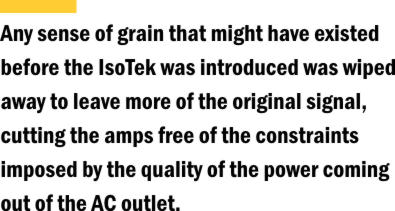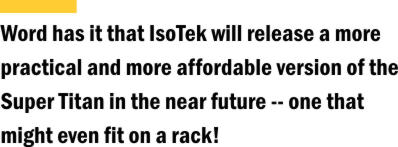IsoTek • EVO3 Super Titan Power Conditioner
ritish audiophiles are somewhat skeptical about power conditioning. After all, we reason, if a company has gone to great lengths to make a product sound good, surely it has put in enough power regulation to make further conditioning unnecessary. Nowhere is this strategy more likely to be the case than with power amps, which need as much juice as possible, and in the least compromised form. Decent power conditioners for amplifiers have been rare during my 25 years of reviewing, so I was quite ready to dismiss the IsoTek EVO3 Super Titan, despite its incredible bulk and top-notch casework. But that was a mistake -- the Super Titan did things for my system that few other products have managed, despite many of them costing more, and sometimes considerably more, than this beast.
Did I say beast? I meant behemoth. The EVO3 Super Titan is huge enough -- 19.5” (500mm) square by 11.7” (300mm) high -- that many visitors mistook it for a serious power amp. Its weight isn’t indicated on IsoTek’s website, but it must be over 110 pounds (50kg). That’s because it contains a lot of chokes -- devices that look like transformers but don’t operate in the same way. These enable the Super Titan to deliver some very big numbers -- specifically, 7360W of continuous power, and transient bursts of up to 35,500W. You can see why it looks and feels like a power amp. Its goal is to deliver high-current power of extremely low impedance that’s devoid of the problems that beset the AC that comes out of your wall socket. The Super Titan aims to remove from the incoming power the two most common and insidious forms of noise: common mode, also known as radio-frequency interference (RFI), and differential mode, aka electromagnetic interference (EMI). EMI comes from computers as well as, nowadays, all domestic appliances that include a basic computer (and some that don’t) -- pretty much anything you plug in adds to the problem. RFI is what you get from your WiFi network, your cell phone, and all forms of terrestrial transmissions. Both RFI and EMI have increased exponentially in recent times, which is likely to be one reason for the increased effectiveness and thus the popularity of power conditioners -- even here in the UK. The Super Titan contains four seven-stage networks, connected in a series/parallel configuration to deliver extremely wide bandwidth filtering via a direct-coupled circuit. It uses Kirchoff’s Equal Resistance Path (KERP) to provide equal resistance and equal power delivery across all four of its outlets, and connects those outlets independent of each other so that there is no cross-contamination between components -- even high-end audio devices emit noise that can affect other parts of the system. The Super Titan’s unusual appearance is a result of its Independent System Isolation Support (ISIS) resonance-control system. This, the exoskeleton that supports the body of the conditioner, was created by German designer and microphony guru Kurt Olbert, who specializes in developing materials for audio applications. In the Super Titan it consists of four corner columns that support the acrylic sandwich structures that sit above and below the main unit. These are designed to kill the floor- and airborne vibrations that presumably affect conditioners just as much as they do other audio devices. Even the shape of the supporting struts is designed to keep resonances to a minimum, and the feet are spiked. This latter detail seems counterintuitive to me, as spikes couple, not isolate, but in the audio business, using spikes is a hard habit to break. There are two versions of the Super Titan. I was sent the 32A model, which requires a dedicated 32-amp power line if it is to deliver that sort of current. Only a few amplifiers actually require this much power, and the 32A version can be plugged into a normal mains circuit, as it was in my room. Its outlets are Neutrik locking types, and the conditioner is supplied with four of IsoTek’s Intense power cords, plus a fifth to connect the conditioner to the wall. That’s five $995 cords, which makes the $13,995 total price seem a bit more palatable. Alternatively, the less expensive 20A version ($11,995) has regular power outlets so that you can use your existing power cords. IsoTek also brought along their Genesis conditioner -- a regenerator with sufficient capacity to handle source components and preamps. At $23,995, it costs nearly twice as much as the Super Titan, but it made a huge improvement. efore introducing the Genesis, I used the Super Titan to power my Valvet monoblocks, which are (confusingly) not valve or tube amps but solid-state, class-A designs. With the Valvets driving PMC Fact 8 speakers, the Super Titan 32 allowed the system to sound considerably more relaxed and natural, despite its being already inclined that way. Importantly, the Super Titan did nothing to upset the pace and timing of the music; if anything, it enhanced these aspects. It also revealed further layers of fine detail, such as the full extent of the reverberation in Michael Hedges’ Aerial Boundaries CD [Windham Hill 1032]. This recording is quite rich in reverb, but there’s more to be heard when you give the power amp a clean source of AC. Dynamics also improved, a natural result of pushing down the noise floor -- you can simply hear more low-level detail when it’s not submerged in noise. I found the overall effect quite transporting; it increased the ability of an already good system to engage both mind and emotions.
Next I tried the Super Titan with an amplifier from Naim, a brand renowned for both its “add-on” power-supply upgrades and its total disdain for all forms of AC treatment or conditioning. You can spend more on better supplies for a Naim source component than on the component itself, so the company clearly appreciates the importance of high-quality power. I tried the IsoTek with the SuperUniti streaming amp, which I’ve been using for a while, and for which Naim doesn’t offer a PSU upgrade. The change was night-and-day obvious. Suddenly there were space, scale, and three-dimensional imaging. Voices were placed within the room, and an electric guitar revealed a radiance that, before, the SuperUniti had only hinted at. In many respects, the SuperUniti stopped sounding like a Naim -- that is, very musical but not as transparent as other amps; the effect was very similar to what one hears with the company’s new DR (discrete regulated) power supplies. Essentially, I heard greater transparency than I usually do from Naim products. The timing was still rock solid, but now I could hear all the fine detail that makes up the sonic picture. There were texture and tonal color at the same time as emotional power. The word transformation doesn’t seem too strong to describe what I heard. I had to have a sit down and a cup of tea before I could come to terms with it! The Super Titan 32 had certainly perked up the SuperUniti, but what was just as impressive was its impact on overall system unity. Naim products in general don’t agree with my usual speaker cables, the Isolda from Townshend Audio, because they need to see high inductance to remain stable and the Isolda has high capacitance. So I’d been using the Atlas Ascent 3.5, which I find a little on the relaxed side in my regular system. With the Super Titan up front, that tendency was gone, the whole system locking together, driven by and responding to the signal -- just because the power had been cleaned up! But it’s not just power, is it? It’s the very essence, the raw material of musical reproduction. Without an AC line, there is no audio system -- it makes sense that the state or quality of that AC will affect the sound; it’s just that you don’t expect that effect to be quite so profound. dding IsoTek’s Genesis with the Super Titan had profound influence on the sound. Junk in, junk out -- if you clean up the front end, then the amplifier has less hash to deal with, and you get a better-than-double reduction in noise. A least it certainly sounded that way. I put the figure "-30dB" in my notes -- irrational even by subjective standards -- but that was the impression it gave, an impression created by notes coming out of the system that were just too low in level to be appreciated before. The first thing I plugged into the Genesis was a Metrum Acoustics Hex DAC. The result was better timing, greater low-level resolution, and, as a result, a sound that was considerably more subtle and delicate than before. I then moved the Naim UnitiServe that was providing signal to the DAC.The UnitiServe is essentially a computer with a digital output stage and a switch-mode power supply; it shouldn’t be very sensitive to vagaries in power. Wrong! Its sound, too, was transformed -- it began to produce a tonal radiance that I had not previously heard from digital audio. Of course, the digital nature of the UnitiServe means that it’s unleashing more noise back into the mains than other components, so limiting its ability to do that meant that everything else had an easier time of it. Using the UnitiServe with the Genesis was half the equation, for sure. The other half was sonic glory of the “Can’t turn it off, who needs to eat?” variety. he IsoTek devices made quite an impact on my system, my listening, and my peace of mind. In fact, I had so much difficulty weaning myself off the Genesis that the Super Titan had to share billing with it from then on. Then an audio show loomed, and IsoTek arrived to take the Super Titan away, leaving me with the Genesis. This wasn’t the end of the world, but it did result in a few weeks of coming to terms with my “old” Valvet power amps again. That was how it felt: the Super Titan transformed the amplifiers’ ability to resolve the musical information they were fed. When it went away, I was left with the sound of regular AC.
Until then, I’m left with the realization that we
ignore AC quality and sophisticated power conditioning at our peril. The times they are
a-changin’, and the ubiquity of computer-controlled appliances, WiFi networks, and
switch-mode power supplies means that old, established wisdoms no longer apply. The Super
Titan 32 is a seriously impressive bit of kit -- as is the Genesis regenerator. Both are
seriously expensive too. If you can afford them and you’ve already invested in a
serious system, then one listen is all it will take to convince you of their value. But in
some ways, their real importance lies in what they tell us about not only the AC supply,
but about our attitudes toward power conditioning itself. This Brit audiophile is
a skeptic no more.
|
||||||||||||




 Moving on to some electronica, in the
form of Bugge Wesseltoft’s Duo CD
[Universal 2770419], I was struck by the enormous amount of space the IsoTek pulled from
the recording. This may have been created in the studio, but it nonetheless made for a
room-filling soundstage in which clever use of reverb and other tweaks delivered realistic
space and dynamics. Wesseltoft abandons the keyboard and starts playing the strings inside
his piano, something I’d noticed before but that had never been revealed with this
degree of clarity or impact. It’s a very nice thing to hear the performance of a
favorite component being enhanced to this degree. The Super Titan didn’t change the
amps’ character, but it allowed them to deliver greater transparency while sounding
distinctly more effortless. Any sense of grain that might have existed before the IsoTek
was introduced was wiped away to leave more of the original signal, cutting the amps free
of the constraints imposed by the quality of the power coming out of the AC outlet.
Moving on to some electronica, in the
form of Bugge Wesseltoft’s Duo CD
[Universal 2770419], I was struck by the enormous amount of space the IsoTek pulled from
the recording. This may have been created in the studio, but it nonetheless made for a
room-filling soundstage in which clever use of reverb and other tweaks delivered realistic
space and dynamics. Wesseltoft abandons the keyboard and starts playing the strings inside
his piano, something I’d noticed before but that had never been revealed with this
degree of clarity or impact. It’s a very nice thing to hear the performance of a
favorite component being enhanced to this degree. The Super Titan didn’t change the
amps’ character, but it allowed them to deliver greater transparency while sounding
distinctly more effortless. Any sense of grain that might have existed before the IsoTek
was introduced was wiped away to leave more of the original signal, cutting the amps free
of the constraints imposed by the quality of the power coming out of the AC outlet. A few months on, I still haven’t
gotten used to that reality. I yearn for the transparency and immediacy that flowed from
the Super Titan’s outlets, the special way it had of opening a window on the music.
Word has it that IsoTek will release a more practical and more affordable version of the
Super Titan in the near future -- one that might even fit on a rack! I’ll be putting
my name down to give it a spin.
A few months on, I still haven’t
gotten used to that reality. I yearn for the transparency and immediacy that flowed from
the Super Titan’s outlets, the special way it had of opening a window on the music.
Word has it that IsoTek will release a more practical and more affordable version of the
Super Titan in the near future -- one that might even fit on a rack! I’ll be putting
my name down to give it a spin.